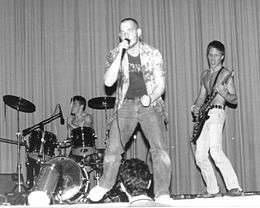Powerviolence
| Powerviolence | |
|---|---|
 Powerviolence pioneers Siege performing at their high school in 1984 | |
| Stylistic origins | |
| Cultural origins | Late 1980s, North America |
| Typical instruments | |
| Derivative forms | Bandana thrash |
| Other topics | |
Powerviolence (sometimes written as power violence) is an extremely dissonant and fast subgenre of hardcore punk which is closely related to thrashcore and grindcore. In contrast with grindcore, which is a "crossover" idiom containing musical aspects of heavy metal, powerviolence is just an augmentation of the most challenging qualities of hardcore punk. Like its predecessors, it is usually socio-politically charged and iconoclastic.
History
Powerviolence's nascent form was pioneered in the late 1980s by Infest.[2] The microgenre solidified into its most commonly recognized form in the early 1990s, with the sounds of bands such as Man Is the Bastard, Crossed Out, Neanderthal, No Comment and Capitalist Casualties. Powerviolence groups took inspiration from Siege, SSD, Deep Wound, Neon Christ, Hirax, Impact Unit, Dirty Rotten Imbeciles, Negative FX and Corrosion of Conformity.
Spazz vocalist and bassist Chris Dodge's record label Slap-a-Ham Records was a fixture during the rapid rise and decline of powerviolence, releasing influential records by Neanderthal, No Comment, Crossed Out, Infest, Slight Slappers, and Spazz.[3] The label's Fiesta Grande was an annual powerviolence festival held at 924 Gilman from 1993 to 2000. Spazz drummer Max Ward's label 625 Thrashcore has started its own festival, Super Sabado Gigante, in a similar vein. While powerviolence is closely related to thrashcore (often referred to simply as "thrash"), the style is distinct from the thrash metal groups active in the same place, at the same time.
Style
While originally the term powerviolence included stylistically diverse bands, powerviolence generally refers to bands who musically focus on speed, brevity, bizarre timing breakdowns, and constant tempo changes. Powerviolence songs are often very short; it is not uncommon for some to last less than twenty seconds. Some groups, particularly Man Is the Bastard, Plutocracy, and No Le$$ took influence from progressive rock, and jazz fusion.[4]
Powerviolence groups tend to be very raw and underproduced, both sonically and in their packaging. Some groups (Man Is the Bastard and Dystopia) took influence from anarcho-punk and crust punk, emphasizing animal rights and anti-militarism. Groups such as Despise You and Lack of Interest wrote lyrics about misanthropy, drugs, and inner-city issues. Groups such as Spazz or Charles Bronson, on the other hand, wrote lyrics mocking points of interest for hardcore and metal fans, or even used inside jokes for lyrics, referencing specific people many of their listeners would not know.
Other groups associated with powerviolence included The Locust, Black Army Jacket, Hellnation, Charles Bronson and Rorschach.[5] The doom metal group Burning Witch also released on Slap-A-Ham and played shows with powerviolence groups.[6]
Legacy and Influence
Powerviolence groups had a strong influence on later grindcore acts, such as Agoraphobic Nosebleed. Mark McCoy of Charles Bronson went on to form Das Oath, a popular thrashcore group. Members of Man Is the Bastard formed Bastard Noise.
A handful of bands from the powerviolence scene of the 1990s have continued to record and perform decades later, including Bastard Noise, Capitalist Casualties, Despise You, Lack of Interest, Infest, Slight Slappers and Stapled Shut. Nails, Magrudergrind and Full of Hell are considered contemporary powerviolence acts.[7][8][9]
Emoviolence
Emoviolence is a fusion genre that combines elements of powerviolence, screamo, and grindcore. Common characteristics shared by emoviolence bands include screamed vocals, blast beats, extensive use of amplifier feedback, and small elements of melody. The term "emoviolence" was jokingly created by the band In/Humanity,[10][11] and bands commonly associated with the term include Orchid,[12] Usurp Synapse,[13] Jeromes Dream,[14] and Pg. 99.[15]
References
- ↑ Butler, Will. "Bastard Noise". Don't Be Swindle. 1: 21.
|access-date=requires|url=(help) - ↑ Preira, Matt. "Six Reasons Why Infest Might Be The Most Hardcore Band Ever". miaminewtimes.com. Miami New Times. Retrieved 2017-04-27.
- ↑ n/a. "An Oral History of Powerviolence". lioncitydiy.blogspot.com. Lion City DIY. Retrieved 2012-02-14.
- ↑ Ivers (2008-03-20), Brandon. "What Is It?: Powerviolence". xlr8r.com. XLR8R. Retrieved 2017-04-28.
- ↑ Andrew Marcus, "Buzz Clip", SF Weekly, August 6, 2003. Access date: August 7, 2008.
- ↑ Slap-a-Ham Discography. Access date August 11, 2008.
- ↑ Preenson, Richard. "What Even is "Thrashcore" Anyway?". Thrown Into the Fire. Retrieved 4 March 2018.
- ↑ MacRae, Meghan. "CVLT NATION'S TOP SEVEN POWERVIOLENCE / GRINDCORE RELEASES OF 2016". Retrieved 4 March 2018.
- ↑ Lake, Daniel. "Full of Hell: Extended Interview". Retrieved 4 March 2018.
- ↑ n/a (2012-10-15). "Interview with Chris Bickel, vocalist of In/Humanity". yellowgreenred.com. Yellow Green Red. Retrieved 2017-04-28.
- ↑ Jason Thompson (15 June 2008). "CIRCLE TAKES THE SQUARE is in the studio". PopMatters. Retrieved 18 May 2011.
- ↑ Greg, Pratt (22 September 2010). "Altered States, Grindcore Special part 2". Terrorizer. United Kingdom: Miranda Yardley (181): 43.
Another interesting sub-subgenre was this strange crossover of first-generation emo and grind. Bands like Reversal of Man or Orchid may not have stood the test of time, but it was a pretty cool sound at the time and one that was pretty uniquely American
- ↑ Morris, Kurt. "Usurp Synapse - Disinformation Fix". allmusic.com. AllMusic. Retrieved 2017-05-07.
- ↑ n/a. "Noisy Sins Of Insect - Discography Review". diyconspiracy.net. DIY Conspiracy. Retrieved 2017-05-07.
- ↑ Tiernan (2015-07-15), Jack. "Starter Kit: Screamo/Emoviolence". heavyblogisheavy.com. Heavy Blog Is Heavy. Retrieved 2017-05-07.